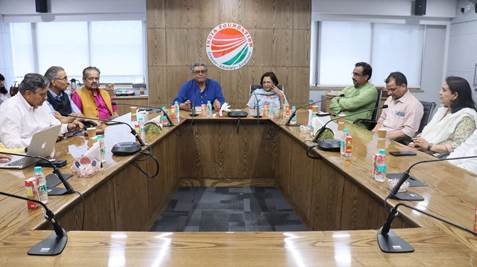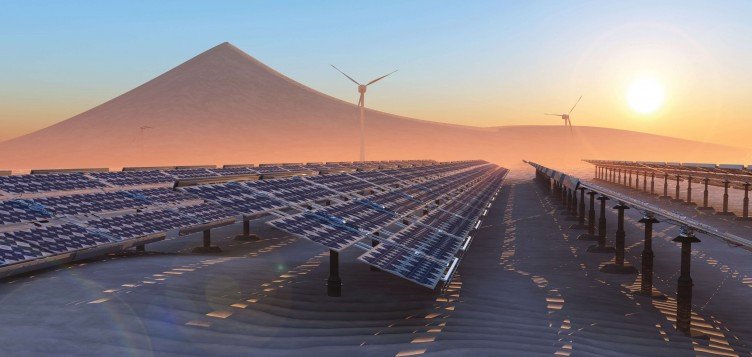كُتِبَ عَلَيْكُمُ الْقِتَالُ وَهُوَ كُرْهٌ لَكُمْ ۖ وَعَسَىٰ أَنْ تَكْرَهُوا شَيْئًا وَهُوَ خَيْرٌ لَكُمْ ۖ
وَعَسَىٰ أَنْ تُحِبُّوا شَيْئًا وَهُوَ شَرٌّ لَكُمْ ۗ وَاللَّهُ يَعْلَمُ وَأَنْتُمْ لَا تَعْلَمُونَ
Warfare has been prescribed for you, though it is repulsive to you. Yet it may be that you dislike something, which is good for you, and it may be that you love something, which is bad for you, and Allah knows and you do not know.
Surat Al Baqara : 216. سورة البقرة : ٢١٦
Introduction
Deaths from terrorism are now at their highest level since 2017- 8,352 in 2023, a 22 per cent increase from the previous year.[1] While ISIS, al-Qaida, and their affiliates have been very active, the major contribution to the death toll was from Hamas. The attack against southern Israel on October 7, 2023, by Hamas and ten other Palestinian armed groups, including the Islamic Jihad, Mujahideen Brigades, Al Nasser Salah al Deen Brigades, etc, has left thousands of dead, destroyed Gaza, and caused a human tragedy of colossal proportions. It has also acted like an adrenaline shot for reinvigorating transnational jihad.
Post October 7, 2023, the two main Jihadi configurations of the Islamic State (ISIS) and al-Qaeda have rejuvenated their subsidiaries, branches, and affiliates and are using the Palestinian cause and alleged human rights abuses in Gaza as the prime platform of their messaging, which aims at expanding their global threat potential. Similarly, the Hamas-Israel conflagration has given impetus to Iran’s Axis partners to invigorate their grid of militias in Iraq, Syria, Yemen, and Lebanon, showcasing Tehran’s strategic influence both in its environs and globally. Christopher Wray, the Director of the FBI, while testifying to the Senate Intelligence Committee in December 2023, spoke of a ‘heightened threat environment’ after October. Earlier, in March 2024, General Michael Erik Kurilla, Commander of the United States Central Command (CENTCOM), observed that the capabilities of ISIS and al-Qaeda, and their affiliated groups, especially ISIS- Khorasan had escalated considerably.[2] The Israel-Hamas conflict, which is now in its 8th month, shows no signs of abating, despite horrific collateral damage and international opprobrium. The current global scenario will certainly throw up substantial challenges for counterterrorism agencies worldwide as jihadi groups will undoubtedly exploit the political fractures and hostilities that have become marked not only in the West Asia and African regions but also in the US, Russia, Europe, and South Asia, leading to proxy war scenarios, wherein counterterrorism initiatives suffer due to mistrust and political intransigence.
Unsurprisingly, 2024 started on a bloody note. On January 3, 2024, ISIS’s affiliate ISIS-Khorasan, attacked the commemorative ceremony marking the killing of the erstwhile IRGC head, Qasem Soleimani, in Kerman, Iran, which killed over 103 people. The same group was responsible for an attack on a Roman Catholic church in Istanbul, killing one person, and the March 22nd attack on the Crocus City Hall music venue in Krasnogorsk, Moscow Oblast, Russia, killing over145. The attacks were all acknowledged by the ISIS mouthpiece Al Amaq News Agency, which also published laudatory messages from other ISIS branches and affiliates from West Asia and Africa. The reach and connections of the group with others in West Asia and Africa have raised blinking red lights, and an assessment of this threat perception is required not only for the security of the West Asia and North Africa (WANA), but globally.
There are now several red flags about possible terrorist attacks, especially in WANA, and about cross continental linkages with south and southeast Asia and the Caucuses. The maps below show the areas, and linkages will be discussed below.[3]
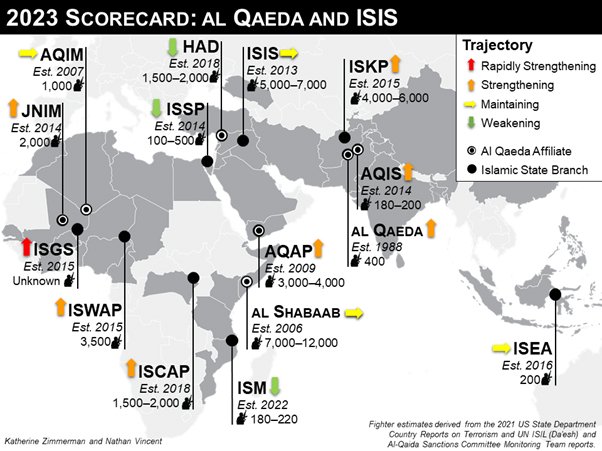
As can be seen, the Salafi-jihadi threat has spread its tentacles around West Asia, Africa, and Asia. They have exploited local conflicts, co-opted local warlords and organised crime syndicates local conflicts and have used extortion and intimidation, apart from radicalisation. to strengthen popular insurgencies which are supportive. These groups have been wildly successful in Africa, where a series of coups have destabilised the region, and seriously hampered counterterrorism operations.[4]
The Taliban takeover in 2021 has provided sanctuary in Afghanistan for training recruits from Africa, West Asia, and South Asia and for arms collection from the withdrawing US forces. This was due to the respite from counterterrorism actions due to a severe breakdown of all government institutions and political and inter-communal conflagrations.
The Libyan situation continues to be grim, with a four-cornered internal insurgency raging, and the situation in Sudan has gone seriously downhill over the past few months due to the conflict between the Sudan Armed Forces (SAF) and the Rapid Support Forces (RSF) escalating in Khartoum, destabilising government control and impacting fragile areas like Darfur, where mass killings and displacement have led to reports of ethnic cleansing.
In Syria, President Bashar Assad has managed to maintain the integrity of his country and the border; the Sykes Picot line remains intact. The central military conflict is now between the Syrian government and Turkish forces and factions within Syria. The conflicts continue to provide an optimum environment for Jihadi groups, which, although weakened, are by no means vanquished. The situation is similar in Iraq, and the Jihadi Salafi groups in the Levant have the potential to create local and global problems.
In 2023-2024, it has been seen that Jihadi Salafi groups, while focussing on the immediate areas of the Islamic world, have not lost sight of the more distant prospects, as evidenced by the Crocus Hall attack in Moscow, several attacks in Europe, and attempts in India and the USA. Post October 7th, there is a real and present danger from a terrorist act, as can be seen from the map of recent incidents given below.[5]

In this article, the transnational links of al-Qaida, ISIS, and other Salafi-Jihadi groups will be discussed, followed by a discussion on Iran’s “axis of resistance” and its burgeoning impact globally, and not just in the West Asian region.
The Global Reach of al-Qaeda: Networks and Allegiances
To revisit old history, Osama Bin Laden (Yemen/Saudi), Abdullah Azzam (Saudi), and Ayman Zawahiri (Egypt) and their cohorts, who had formed the Maktab al Khidmat, had been removed from Sudan at the encouragement of the US, as they had earned the ire of the Saudi Royal family, who did not want a Salafi contingent in a neighbouring country. The group was transported to Afghanistan by the US, and Nasrullah Babar, the then interior minister of Pakistan, introduced them to Mullah Omar, the Emir of the Taliban, to fight against the Soviet army. The Taliban, under the instructions of the Pakistani ISI, was told to extend them logistical and material help and fight under their guidance.
Post the Soviet defeat in 1988, the Maktab al Khidmat morphed into the al-Qaida, ostensibly for the spearheading of a global Islamic revolution that would eventually culminate in a Caliphate. The founders envisaged it as a “base” to which many other Jihadi outfits, like those from Uzbekistan and Xinjiang, and even the Rohingyas would join with the Ansars (foreign fighters). The al-Qaida was to stay as honoured guests of the Taliban and would acknowledge the Emir of the Taliban to be the Emir ul Momineen, the supreme leader of an Islamic community. The initial political motivations of settling the founders of al-Qaida, to use them against the Soviets, spectacularly backfired, leading to the bombing of the Kenyan embassy in August 1988, on the attack on USS Cole on October 12, 2000, in Aden, Yemen, and of course, the 9/11 attacks in the US.
Despite severe degradation following Operation Enduring Freedom, launched after 9/11, al-Qaida, after a short sabbatical, has emerged on the Global Jihadi map and has evolved into a decentralised network, with numerous affiliated groups across the globe pledging allegiance to its leadership.
Al-Qaida leadership
Al-Qaida faced a severe leadership crisis after the assassination of Osama bin Laden in 2011, followed by Anwar al Awlakki in Yemen in a drone strike (2011), and Nasir al Wuhyashi, who had been anointed as the next head of al-Qaida by Osama bin Laden, was also killed in Mukalla, Yemen, in 2015. The mantle of leadership did not fall on Ayman Zawahari, who was relegated to the position of group ideologue and notional Emir, with little control over day-to-day functioning or operational details. Operations and finances were being managed by Saif al Adel, based in Tehran, and Qassim al Raymi, the then head of the AQAP. They had envisaged and operationalised an attack against the US Naval Air Station Pensacola in Florida in December 2019. The leadership council of the al-Qaida, including Zawahiri, was unaware of the operation, which caused considerable disarray in the Group’s central administration. Though he was nominally named the Emir of al-Qaida, his killing in a drone strike in the posh Wazir Akbar Khan area of Kabul in 2022 made little difference, and he has not been eulogised by the al-Qaida social media or print mouthpieces.[6]
Saif al Adel @ Mohammad Salah al Din Zaidan
Seif al Adel, an erstwhile special forces officer from Egypt who had been closely associated with Osama bin Laden in Afghanistan and Pakistan, was earlier arrested when he, along with Osama bin Laden’s sons, Saad and Hamza, escaped to Iran. He was released through the efforts of Nasir al Wuhyasi, the then head of the AQAP, along with other cadres (see photo below), but refused to leave Teheran. Adel, who was reportedly close to the slain IRGC chief Qassem Soleimani, claimed that it would be better to have an al-Qaida presence in Iran, as there was a commonality of interest between the Iranian regime and the group regarding the “distant enemy,” the USA. His reluctance to leave Iran created dissent with the al-Qaida Central branch based in Afghanistan. Still, he bolstered his position by getting Tehran to have a line of communication with the al-Qaida, and by resonance with the Taliban. It needs to be noted, though, that the Iranian regime has refused to acknowledge the presence of Saif al Adel or other al-Qaida cadres in Iran. Also, it is significant to note that most attacks in Iran have been perpetrated by the ISIS, barring those by Baloch groups like Jaish e Adl in Sistan Baluchistan Province, and not by al-Qaida.
Saif Al Adel established control of the AQAP-al Qaida in the Arabian Peninsula and co-opted its leaders. Saif al-Adel won the support of the Yemeni branch and used it to increase his direct influence in Syria. He created a new al-Qaeda group in Syria called Hurras al-Din (the Guardians of Religion) and established a channel for transferring funds and fighters from Yemen to Syria. This group worked along with the Jabhat ul Nusra, headed by Mohammed al Julani, the main AQ branch in Syria. These groups continue to be active in Syria under the tutelage of Adel. While counter-terrorism attacks by the US have degraded ISIS in the Levant considerably, the AQ fronts have been more insidious, won over allies from the Syrian armed opposition, and their cadres are actively involved with local governance in the large tracts of ungoverned areas in Syria, which also helps in getting funding through ill legal oil trades.
Situation with the AQAP
Meanwhile, in Yemen, Saad bin Atef al Awlakki, an acolyte of Saif Al Adel, was appointed as head in May this year following the assassination of the previous head, Khalid Batrafi. Awlakki is Yemeni and has made a public call to the provinces of Abyan and Shabwa in south Yemen to resist any overtures from the UAE government. With his ascension, reconciliation with the UAE and Saudi Arabia seems remote. Of great concern is that the AQAP has considerable heft in the provinces of Abyan, Shabwa, Marib, the port of Mukalla, Hadramawt and north Aden. AQAP has targeted armed groups backed by the UAE, such as the Southern Transitional Council, Security Belt, Shabwani Elite, and Shabwah Defense Forces, stating that Emirati mercenaries needed to be eliminated. Due to Saif Al Adel and the current AQ policy, they have no significant differences with the Houthis, who are acting as proxies of Iran, and since 2022, there have been no attacks by AQAP on the Houthis.
Saif Al Adel established control of the AQAP (al-Qaida in the Arabian Peninsula) and co-opted its leaders. Saif al-Adel won the support of the Yemeni branch and used it to increase his direct influence in Syria. He created a new al-Qaeda group in Syria called Hurras al-Din (the Guardians of Religion) and established a channel for transferring funds and fighters from Yemen to Syria. This group worked along with the Jabhat ul Nusra, headed by Mohammed al Julani, the main AQ branch in Syria. These groups continue to be active in Syria under the tutelage of Adel. While counter-terrorism attacks by the US have degraded ISIS in the Levant considerably, the AQ fronts have been more insidious, won over allies from the Syrian armed opposition, and their cadres are actively involved with local governance in the large tracts of ungoverned areas in Syria, which also helps in getting funding through ill legal oil trades.
Al Shabaab and its importance
The above development in Yemen needs to be assessed against the backdrop that the Al Shabaab, an affiliate of al-Qaida, has gained considerable ground in Somalia, even within the northern region of Puntland, and the port of Bossaso, which is on the other side of Aden across the Gulf of Aden, a main international shipping route. Harakat al Shabaab al Mujahideen, known as Al Shabaab (the youth), was formed by Aden Hashi Farah Aryo, a mujahideen trained in Afghanistan. It gained traction during Somalia’s civil war in the 1990s as an alliance of shari’a courts and local armed groups which gained power and territory during the 2006 Ethiopian invasion. It once controlled over 40% of the territory, including parts of Mogadishu. It is now headed by Ahmed Diriye, also known as Ahmed Umar Abu Ubaidah, who was involved in the West Mall attack in Kenya in 2013 and is a UN-designated terrorist.
Al Shabaab is showing remarkable resilience to counterterrorism initiatives by the African Union’s Transition Mission to Somalia (ATMIS) and Somali government forces and has often routed them with high levels of attrition. The ATMIS is winding down operations in Somalia, and it is apprehended that the resulting power vacuum will allow the Al Shabaab greater latitude. The group has now established some bases in Puntland, one area where international piracy initiatives were launched. The Al Shabaab leadership leaders have been covertly funding Somali pirates for revenue generation. Of global concern is the deal that the Houthis are forging with Al Shabaab for the supply of weapons. The two groups have an understanding, despite sectarian differences, that arms supply such as surface-to-air missiles and attack drones to the al Shabaab would seriously deteriorate the security scenario around the Gulf of Aden and Bab el Mandeb, the main shipping routes, especially for oil.[7]
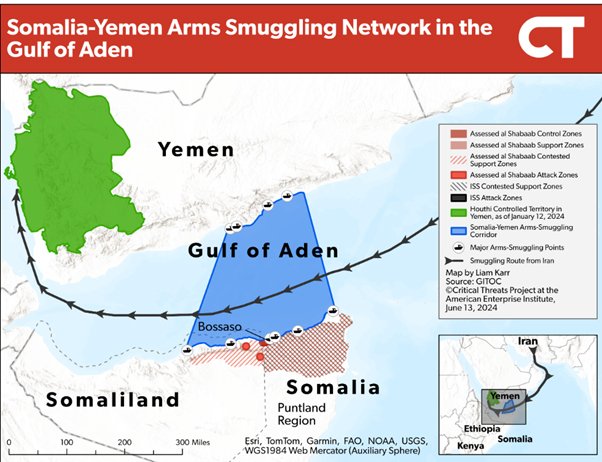
Jama Nasr al-Islam wal Muslimin-JNIM
The JNIM, which translates as the Group for the Support of Islam and Muslims, is a prominent jihadist organisation in West Africa which was formed in March 2017. The JNIM is an amalgamation of several regional extremist groups, including Al-Qaeda in the Islamic Maghreb (AQIM), Ansar Dine, the Macina Liberation Front, and Al-Mourabitoun. The Group’s formation was publicly announced by its leaders in a video message, signalling a unified front for Al-Qaeda. This was evidenced in the joint statement given out after the Hamas attack on Israel, which fulsomely praised Hamas and called for further attacks on Jews. The Group, which has expanded its reach across the Sahel region, including Mali, Niger, and Burkina Faso, aims to overthrow local governments and establish an Islamic state governed by Sharia law. It has engaged in kidnapping for ransom, attacks on military and civilian targets, and collaboration with other jihadist factions. The Group is closely affiliated with the AQAP and the Central AQ in Afghanistan.
The leader of JNIM is Iyad Ag Ghaly, a Malian Tuareg who previously led Ansar Dine. He was instrumental in removing French and other foreign troops from Mali. Under his command, the Group has pursued an agenda of implementing strict Sharia law for which he has formed various sub-units operating semi-autonomously across Mali, Burkina Faso, and Niger. This decentralised approach allows JNIM to adapt to local conditions and maintain resilience, and it has shown considerable success against counter-terrorism efforts.
The Group has claimed responsibility for the attack on June 11, 2024, that killed over 100 Burkina Faso soldiers in Mansila area near the border with Niger. The site of the attack was close to the borders with Niger and Mali; both countries host insurgencies linked to both Al Qaeda and Islamic State. In another major attack on a gendarmerie and civilian auxiliary post in Burkina Faso on May 5, 2024, and a Nigerian army base on May 20 2024, over 100 people were killed. The brutality of the attacks has caused military forces to abandon the targeted bases, creating a power vacuum which the JNIM is filling. The political fallout has been a drift of the weakened governments towards Russia, causing consternation amongst the US and allies about potential strategic losses over political heft and valuable natural resources.
Call for Jihad
Saif Al Adel, the Emir of the Al Qaida, called (June 2024) upon “the loyal people of the Ummah interested in change to go to Afghanistan, learn from its conditions, and benefit from the Taliban’s experience. This call was issued by the as-Sahab media, a mouthpiece of the organisation, titled “This is Gaza: A War of Existence, Not a War of Borders.”[8]
The call makes it clear that al Qaida has established bases in Afghanistan, and believe that they have political immunity there. His call for’ Hijra’ is reminiscent of the early 1990s. He further adds that all Islamic people should strike to cause maximum pain against ‘Zionist” targets around the world.[9]
Simultaneously, the AQAP has launched a new online anti-West propaganda campaign called “Inspire Tweets” which exhorts the Ummah that jihad is the only solution, the need of the hour is for supporters to engage in various types of attacks including bombings, armed assaults on unexpected targets, and strikes on train stations and airports to retaliate for killing Muslims. Additionally, the campaign calls on al-Qaeda supporters to carry out cyberattacks to hurt western economies. Earlier in December 2023, tweets asked followers to use ‘Open-Source Jihad (OSJ)’ material titled ‘The Hidden Bomb,’ directed at lone wolves, and groups of supporters, which had guidelines and tips on how to make IEDs, bypass standard security measures in United States airports etc.[10]
This call for Hijra and the open-source jihad needs to be seen in tandem with a United Nations Analytical Support and Sanctions Monitoring Team report dated January 29th that states that the al-Qaida has opened eight new training camps, five madrasas, a weapons depot and safe houses in Afghanistan, that are used to facilitate the movement of its members to and from Iran and other areas in West Asia and Africa. The report further reiterates the close connection between the Taliban and al-Qaida.[11]
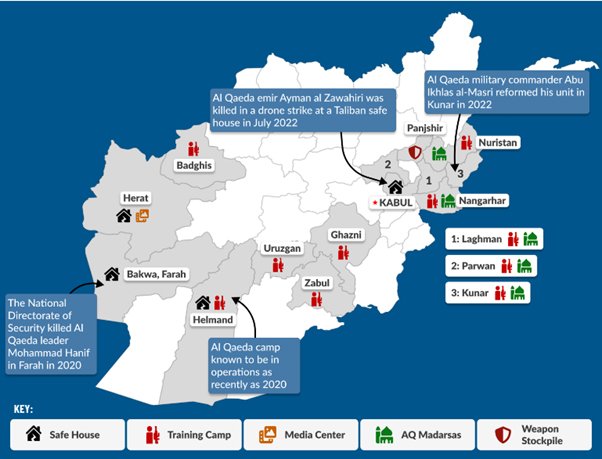
Afghanistan and Transnational Jihad
With al-Qaida opening doors for foreign jihadis, the pathway has also been facilitated for ISIS cadres, especially as ISKP has become one of the most active vilayats of ISIS. This, combined with the anti-migration policies of the EU and USA, will likely cause a reverse flow into Afghanistan. Several Jihadis from various countries are now seen in Afghanistan, an eerie recall of the early 1990s.
Over the last few decades, several jihadist organisations have tried to get a global outreach, be it the AQ, AQAP, Al Shabaab, or the various factions of ISIS. ISKP has been spectacularly successful, as witnessed in the latest attacks in Iran, Turkiye, and Moscow. But unlike other groups, the ISKP has no stable space in Afghanistan and is in constant battle with the Taliban and AQ, both for control of territory and drug trading routes. Since 2022, the Taliban, with some international help, has been systematically degrading the ISKP. On its part, ISIS, in the August 28, 2022, issue of its Pushto magazine Khorasan Ghag, claimed that its reduced activity was because the group’s Emir -Shahad al Muhajir had decided on a “strategic silence” policy. The policy was soon revised, and the group set up the Azaim Media Foundation, which publishes in Arabic, English, Pushto Urdu, Russian, Swahili, etc. The online messages and tweets are getting responses from all over West Asia and Africa for recruitment, funding, and logistic support.
Hence, it is seen that despite claims by the Taliban that no foreign terrorist group would be able to function on Afghan soil, the quality and number of attacks have escalated since 2022 end. The ISKP, from its tenuous holdings in Afghanistan, has set up recruitment and financial networks in West Asia, Europe, Somalia, and the US and has emerged as an integral part of the transnational jihad and one of the main contributors to ISIS’s terrorist profile.
ISIS in Syria and Iraq
On March 23, 2019, the coalition forces, led by the USA, claimed that they had liberated the final stretch of territory controlled by ISIS in Baghuz, Syria. But though ISIS has lost Mosul (Iraq) and Raqqa (Syria) and has been degraded in Syria and Iraq, the group is far from moribund, has a network of agents and sleeper cells in those countries, and has systematically set up branches all over the globe. In the Levant, counterterrorism pressure has degraded the Islamic State’s global senior leadership, including those leading efforts to conduct attacks in Europe. However, despite significant losses among senior ranks, the group has adapted by decentralising its command structures. The name of the current Caliph -the fifth one- Abu Hafs Al-Hashimi Al-Quraishi, was announced in August 2023 by his spokesman Al-Ansari. He has, however, ostensibly for security reasons, remained undercover, and his real identity is unknown, which has led members to question his credentials. In November 2023, the pro-ISIS Bariqah News Agency hinted that an audio or video message by the Caliph might not be ready for quite some time, indicating that he will remain undercover. Some reports have suggested that he has travelled from Yemen to Somalia.
This appears to be a real possibility, as for the present the ISS- Islamic State in Somalia, is the most active branch, which has strong links with ISKP. Following the January 4, 2024, audio message by ISIS Spokesman Abu Ḥudhayfah Al-Ansari, in which he pledged to escalate attacks across all regions in support of the “Muslims” in Gaza., there has been a quantifiable increase in violence and threat perceptions in the region has escalated. Currently there are an estimated 2500 Islamic State fighters in Syria and Iraq— more than double estimates from late January.
There have been around 69 confirmed attacks by the Islamic State in central Syria till June 2024.The attacks in Badia, in March this year resulted in the deaths of at least 84 Syrian soldiers and 44 civilians. This was followed by attacks in the desert area of Homs, with over 15 soldiers of the Syrian armed forces loyal to President Bashar Assad killed. The scale of violence against the security forces was alarming as ISIS cadres stormed regime outposts, ambushed patrols, capturing and executing soldiers and capturing arms. There were also targeted attacks on the US backed Syrian Democratic Forces (SDF). Armed forces abandoned posts, leaving large swathes of the country without security cover. The UN assessed in January this year that the IS had established an operational hub in the Badia desert in Central Syria, but opined that it was likely that Syrian Government and Russian forces would neutralise/ contain it soon.[12]
The situation is similar in Iraq. Of note is the attack on May 13, 2024, this year on military outposts in eastern Diyala and Salahuddin provinces, where a commanding officer and several soldiers were killed. These attacks in Syria and Iraq suggest that the rural areas continue to harbour militant cells, and that the earlier declaration of victory over ISIS in Iraq and Syria by the U.S was a little premature. Problems, including sectarian divisions and proxy wars, have undeniably undermined the Iraqi government’s counter terrorism efforts and enabled the ISIS’s revival. The Iraqi government has also been hamstrung by the U.S. partial withdrawal of forces in 2021, but the armed forces are rallying around, and have conducted several counter-terrorist operations. In March 2024 , the Iraqi forces launched a notable offensive, that resulted in the death of a prominent ISIS leader, Samir Khader Sharif Shihan al-Nimrawi who was the point person for transfer of funds arms and cadres between Syria and Iraq.
Moreover, Prime Minister Mohammad Al-Sudani’s government has had to battle crippling sectarian polarisation that occurred after the US intervention in Iraq in2003. This problem is still some way before resolution, and added to the current geopolitical turmoil in the region stemming from the ongoing Israel–Hamas war has undermined regional stability and encouraged ISIS’s resurgence in the region.
ISIS in North Africa
Over the last few years, successful counterterrorism operations and the rigid enforcement of strict national anti-terrorism legislation, coupled with innovative deradicalisation and rehabilitation programmes, have diminished the threat posed by ISIS in Egypt. The Egyptian government has invested in several development and infrastructure policies in the area where the local branch of the Islamic State, also known as vilayat Sinai or Ansar Bayt al-Maqdis (ABM) is active. However there still are some active cadres who periodically attempt to attack the Security forces, especially around the Sinai. The last violent clash between the Egyptian army and ABM was in 2022 near the Suez Canal. Still, the terrorists were soon overpowered, a tribute to the excellence of the Egyptian intelligence service, the GIS (General Intelligence Service). It needs to be pointed out that the GIS, which has excellent HUMINT, had informed Mossad about the possibility of a major Hamas attack across the Gaza Strip in September this year.
In Libya, jihadist groups are facing several challenges due to sustained counterterrorism attacks against their positions. In southern areas like Fezzan, clashes between the Islamic State and Al-Qaeda are helping security forces. On its part the ISIS, exploiting the political and economic predicament in southern Libya is cooperating with tribal elements involved in smuggling, human trafficking and illicit trade, which helps the group to be financially stable and helps recruitment. According to a recent report by Europol, Syrian mercenaries – often with radicalised profiles are being brought into Libya– by Russia (through the Wagner Group), who might pose additional security risks to the country.
Morocco has not had an Islamist-inspired attack since 2018 but remains vigilant over the offline and online threat of violent extremism. The Moroccan intelligence has prevented several attacks and dismantled jihadist cells that operate in cyberspace. The Moroccon deradicalisation and reintegration programmes, such as ‘Moussalaha’ (‘Reconciliation’), have proved to be very successful and can serve as a blue print for other countries. It has benefited hundreds of jihadists, especially foreign terrorist fighters (FTFs) returnees. The situation in Algeria is much the same, and due to tight security mechanisms and reconciliation policies that allow jihadists who surrender to security services, which would give them information, to receive amnesty and economic assistance.
Tunisia continues to face several terrorist-related challenges. Jihadist groups such as Katibat Uqba Bin Nafi (KUIN) and Jund Al-Khilafa (JAK), which, though weakened – are active in the mountainous areas along the Tunisian-Algerian border. They pose the risk of guerrilla /lone wolf attacks. Also, Tunisian rehabilitation programmes are not as well received or as exhaustive as the Moroccan programmes, and hence, Algiers continues to face problems with the foreign returned fighters.[13]
Map of Jihadist groups in Africa
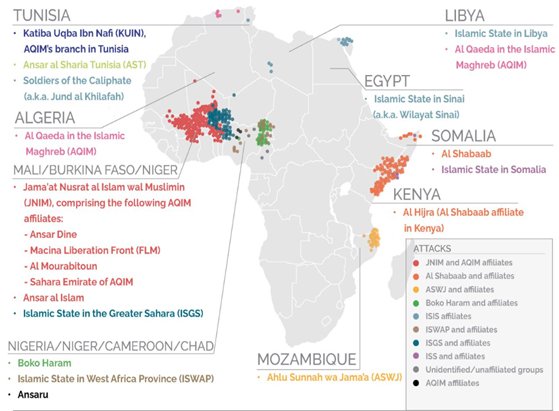
[14]
Jihadi groups in Africa
Violent conflict is one of the main factors driving terrorism, with over 90 per cent of attacks and 98 per cent of terrorism deaths in 2023 taking place in countries in conflict; all the African countries impacted by terrorism have been involved in prolonged armed struggles. In the current global scenario, the epicentre of terrorism has shifted from West Asia and North Africa into sub-Saharan Africa, mainly in the Sahel. Around 59 per cent of all fatalities due to terrorist attacks are from the Sahel, with significant contributions from Burkina Faso, Mali, Mauritania, Nigeria, Niger, and Somalia in the east. These conflicts are important as they often morph into proxy wars with powerful countries, which signal a lack of ethics. These proxies usually result in debilitated governance, mass migration, hunger, and uncontrolled climate change, leading to coups with uncertain futures. Apart from endangering relations with neighbouring countries, many nations with coups have withdrawn from international bodies such as ECOWAS and local peacekeeping forces.
The nexus between organised crime and terrorist groups in the Sahel is marked by illegal gold mining and oil trading, apart from human and drug trafficking, kidnapping and extortion, and livestock hustling and activities such as cattle and livestock rustling.[15] Notable examples of such groups are the JNIM, the Boko Haram in Nigeria, etc, which are affiliated with al-Qaida and the Islamic State vilayats in Africa. These are usually active in the same areas, frequently leading to violent clashes between the groups. While these clashes have a debilitating effect on the social fabric, resulting in mass migration and human rights abuses, they help counterterrorism initiatives by local governments and international agencies. Criminal activities ensure that these groups in the Sahel are reasonably well funded and able to support the central leadership, including proactive branches like the ISKP.
ISIS DRC
According to U.S. Intelligence, the senior ISIS leadership is of the view that Africa is an area where they should invest time and energy, as the continuing conflicts there make for a permissive environment. The I.S. announced the launch of the Islamic State Central Africa Province (ISCAP) in April 2019 as a unified structure between ISIS-Democratic DRC and ISIS-Mozambique. The Allied Democratic Forces (ADF), a Ugandan Muslim insurgent faction active in eastern Congo since the 1990s, had committed a wave of brutal attacks on civilians in late 2019 and killed around 850 people last year, according to U.N. figures. The ADF, which gained prominence for attacking Christian communities, has morphed into the ISCAP, which is now trying to expand its sphere of influence. The group is said to be involved in diamond and gold smuggling and has efficient financial and recruitment networks.[16]
Ugandan and DRC armed forces have been launching attacks on ISCAP positions, but the group has shown considerable resilience. On January 24th this year, ISCAP launched a major attack in Ngite, in the territory of Beni, in resource-rich North Kivu province, which borders Rwanda, causing security forces to withdraw from the area. ISCAP has entrenched itself in the region, which is on the route of transporting Cobalt and diamonds. In December, the group was accused of two attacks in western Uganda in which 13 villagers were killed. The DRC, which continues to have a low-intensity conflagration with Rwanda, is conducive to I.S. growth due to its internal turmoil. The ISCAP could cause severe problems in the future and impact WANA.
Islamic State in Somalia (ISS)
ISIS’s financial strength and sustainability depend on maintaining safe havens and global connectivity. Hence, the group’s leadership has prioritised independent revenue streams for its vilayats by establishing regional control hubs called the Administration of Distant Provinces (ADP), which later (2022) evolved into the General Directorate of Provinces (GDP). ISIS in Somalia (ISS) has generated millions of dollars from extortion, supporting piracy and exploiting the Somali financial system to launder money through hawala and mobile money transfers. The ISS emerged as ISIS’s primary revenue generator, earning approximately USD 6 million. Hence, its local office in al-Karrar, Somalia, has been made the regional General Directorate of Provinces (GDP) with control over Yemen, Kenya, etc. Given its importance in the financial system of ISIS, the US initiated a counterterrorism initiative to kill the head of the GDP in Somalia, Bilal al Sudani, in 2023, which was successful. Abdul Qadir Munim, an influential cleric, has been appointed in his place, and he wields considerable influence in ISIS, next only to the Emir. Recently, the al Karrar Office routed funding through various hawala in the region, including South Africa, and has used South Africa-based banks to transfer funds from the GDP to other ISIS vilayats. Reports suggest that funding and logistic help have been given to the ISKP from the al Karrar office.
Conclusions
- The Hamas attack on October 7th has reinvigorated the global Jihadi scenario.
- Groups affiliated with Iran, including the Hamas, Palestinian Islamic Jihad, Hizbollah, and the Houthis have stated that they will attack Israeli interests globally, and will also attack US and Western interests for supporting Tel Aviv.
- There is a definite understanding between Iran and the Al Qaida, which can be seen with all the branches and affiliates of the group. Sectarian differences have been subdued for joint action against the US and Israel.
- The Emir of the Al Qaida, Saif al Adel, has asked all Jihadis to go to Afghanistan for training. He has also called for reviving Open-Source Jihad for facilitating group and lone wolf attacks.
- This is important for India, as the Lashkar-e Toiba, Pakistan, has traditionally been cooperating with the al Qaida.
- This call is also important as anti- migration policies are now coming into play, and this could cause a flow of militants back into Afghanistan, and through porous borders into Pakistan, which could have security implications for India. This would energise the Al Qaida in the Indian sub-continent-AQIS, which has a number of Indian members.
- The Gulf of Aden which is a crucial choke point in the energy supply routes is being targeted by the Houthis, who have attacked ships in the area, and have even reached up to Socotra Island, which is a matter of great concern for India.
- Houthis are cooperating with Al Shabaab, an Al Qaida affiliate in Somalia, and have reached an agreement to share weapons and logistic support. Al Shabaab has funded Piracy for revenue generation. Arms and cadres reaching Somalia could easily be transported to the Indian sub-continent.
- ISIS and Al Qaida rivalry is wreaking havoc in Africa. Both groups are trying to generate revenue through illegal utilisation of the natural resources there.
- Proxy wars and power plays are being enacted in Africa which will have global ramifications.
To sum up: there are flashing danger signals following the Hamas attack and its aftermath. There is an immediate need for greater security measures coupled with serious initiatives for confidence building and integrating Muslim groups.
To quote Rumi- “Out beyond the ideas of wrong doing and right doing, there is a field. I’ll meet you there.”
Author Bio: Ms. Prabha Rao is a Distinguished Fellow, India Foundation. She is also the Executive Director, South Asian Institute for Strategic Affairs and Distinguished Scholar at the Institute for Defence Studies and Analyses, New Delhi. She is a former IPS officer from Karnataka cadre (1982 batch) who went on a deputation to cabinet secretariat and served in several locations abroad. She also runs an NGO — Encourage India, for skilling victims of trafficking and left-wing extremism.
References:
[1] https://www.economicsandpeace.org/wp-content/uploads/2024/02/GTI-2024-web-290224.pdf
[2] https://www.foreignaffairs.com/united-states/terrorism-warning-lights-are-blinking-red-again
[3] https://www.aei.org/articles/the-state-of-al-qaeda-and-isis-in-2023/
[4] https://www.aei.org/articles/the-state-of-al-qaeda-and-isis-in-2023/
[5] https://www.christiandaily.com/news/africa-surpasses-middle-east-as-the-epicenter-of-terrorism.html
[6] https://sanaacenter.org/publications/analysis/
[7] https://x.com/criticalthreats/status/1801641885577957775
[8] https://x.com/CJBdingo25/status/1804433672705090031
[9] Longwarjournal.org/archives/2024/06/al-qaeda-leader-calls-foreign-fighters-to-afghanistan.php
[10] https://www.counterterrorismgroup.com/post/the-hidden-bomb-inspire-releases-footage-detailing-household-bomb-making
[11] https://www.longwarjournal.org/archives/2024/05/architect-of-doha-agreement-wrongly-claims-al-qaeda-in-the-indian-subcontinent-has-been-dismantled.php
[12]https://x.com/GreyDynamics/status/1806206097876775146ref_src=twsrc%5Egoogle%7Ctwcamp%5Eserp%7Ctwgr%5Etweet
[13] https://www.ispionline.it/en/publication/jihadism-in-north-africa-a-resilient-threat-in-times-of-global-crises-132039
[14] https://www.realinstitutoelcano.org/en/report/riders-on-the-storm-north-africas-pathways-to-resilience/
[15] https://www.economicsandpeace.org/wp-content/uploads/2024/02/GTI-2024-web-290224.pdf
[16] https://home.treasury.gov/system/files/136/Fact-Sheet-Countering-ISIS-Financing-2-27-24.pdf
















